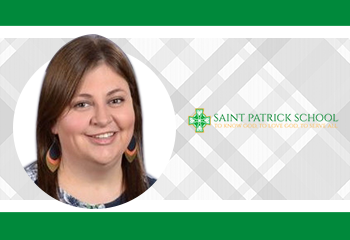
This story originally appeared in the June 2020 issue of FAITH Grand Rapids magazine. It was written by Ms. Elizabeth D’Aurora, who teaches third grade at St. Patrick Catholic School in Parnell.
Finding God amid the chaos
What the pandemic taught this teacher and her third-grade students
St. Teresa of Calcutta has been credited with saying that God doesn’t give us more than we can handle. Her words come to mind as I reflect on the challenges and rewards of teaching my students in the midst of a pandemic.
On the morning of March 13, when we learned our school building would be closed for at least three weeks, I sat in the library at St. Patrick School in Parnell with my friends and colleagues planning a way forward. In a school that serves students in preschool through eighth grade in a rural area, there were many and varied obstacles to overcome. It was tempting to focus on all the things that were making this hard and overlook the commonality that could help us move forward: We are a Catholic school. Our faith is at the foundation of all we do.
When I left our meeting that day, I knew two things: The situation felt impossible. And I already had everything I needed in/through my faith. I decided to approach distance learning the same way that we approach school life, by explicitly making our faith a part of everything we do.
My students and I experienced a range of emotions during the first few weeks of distance learning. I realized pretty quickly that not only was I mourning this special time of the year with my students, but they were also missing our daily routine, things they had been looking forward to, and our third-grade family.
During our second week at home, I set up our first Zoom meeting. It is hard to describe how encouraging it was to see their faces in the tiny frames on my computer. In that moment, I realized how much I had underestimated the importance our third-grade community held for each of us.
After Easter, when we knew that we were not going to be coming back to school for the year, I decided that I wanted to do something every day to keep us connected, encourage creativity and remind my students that God is present in everything. I asked my students to make crosses out of household items based on a new theme each day, take a picture and send it to me. I then created a collage and shared it on social media.
The number of comments that I have had, including those from people who are not members of our school community, church community or even people who consider themselves people of faith, has been astounding. These third-graders have been evangelizers in the best tradition of St. Francis of Assisi, who said: “Preach the Gospel at all times. When necessary, use words.” No words needed here.
This has not been an easy lift. In fact, it has been the most difficult experience of my teaching career. There have been lots of days that I have had to listen hard to hear the voice of God over the other voices in my head screaming that “this is too hard, I am not doing a good enough job, I didn’t sign up for this …”
But if I sit quietly with God long enough, I hear his voice reminding me, “Do not be afraid, I am with you.” And I relax and figure out what to do next. My biggest takeaway from this experience so far is that being a teacher has made me a better learner. The lesson I try to instill in my students – looking for God amid chaos – is what we are all learning alongside each other.
Catholic schools in the Diocese of Grand Rapids are an alliance of 31 vibrant learning communities (26 elementary and five high schools) serving more than 6,340 preschool through 12th grade students throughout West Michigan. Our schools inspire young people to grow in Catholic faith and grace, achieve more in school and life, develop creativity and character, and feel welcomed and cherished for their unique gifts. We partner with parents to awaken the whole child to a world of light and life — that grows better and brighter when children reach their potential.




